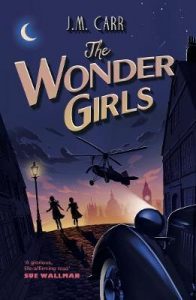
The Wonder Girls written by J.M.Carr
cover by Anne Glenn Design
published by Cindy Press October 2019
320 pages in paperback
A 30s girl gang take on the Blackshirts
Summary from Toppsta
ENGLAND 1936 The Blackshirts, British supporters of Adolf Hitler, are marching. Londoners are on the streets resisting them. In the chaos, a terrified, golden-haired girl pulls street-thief Baby from certain death. But Blackshirts overpower them and seize the girl. Baby tracks the Blackshirts to the coast where she finds a railway carriage hidden in brambles, a gang of renegade girls and thirteen-year-old Ida, trying to protect her golden-haired little sister …
note from reviewer
I don’t usually review ‘straight’ historical fiction. And I certainly don’t review self-published works as a rule. But I’ve known Jan for years, and she’s my SCBWI friend through-and-through. She had me intrigued with her earliest versions of The Wonder Girls. Tag line: 30s girl gang take on the Blackshirts. Who wouldn’t want to read that?
A Reader’s perspective:
From my note above you’ll understand I was a tidgy bit worried. What would I do if it wasn’t up to much? The cover reassured me immediately. Anne Glenn’s artwork is so stylish – remiscent of posters in the Golden Age of ocean liners. Perfect for a Southampton-based writer – and for the 1930s setting.
Then there were Sue Wallman’s cover remarks. Sue knows good stuff when she reads it. If there is anything I associate with Jan’s style it is ‘life-affirming’. And if you know Jan Carr’s fabulously creative craft work, you will have some idea of what to expect: colour, warmth and individual style. It has all that in spades.
A particularly successful feature is the evocation of working class life: it could make for interesting discussions with younger readers! Besides that, the underlying history and its relevance to our current affairs could hardly be more timely.
The Wonder Girls is a lively read, full of adventure and (largely) young people taking action. I found the mix of older and younger characters with agency especially relevant and credible in that period setting. There are elements of nostalgia for older readers (think early Call the Midwife) and the specifics in scene setting are spot on. There’s a good deal to explore about social class, and the place of women and girls too.
But setting the historical details aside, it is the focus on family, friendship and loyalty that makes a lasting impression. Throughout the interwoven story lines of Baby, Fingers and and Sophie at the start and following Ida Barnes next, the whole tale is fundamentally warmhearted. There is peril, and girl power, and fascist louts – but the core is both humane and full of hope. So I needn’t have worried.
NB I’d say The Wonder Girls would suit a reasonably experienced independent reader. The language and style are not difficult but there are a few twisty plot strands to pursue through the 41 short chapters.

Author, activist and all-round creativer person: J. M. Carr
A Writer and Editor’s hightlights
- Excellent idea to hire a professional book designer for an independently produced book.
- Naming your press after your dog is charming!
- The Buy section on J. M. Carr’s website gives links to indie booksellers. (More of this, please.)
- The Read page gives you the first two chapters.(Note the elegant Art Deco font for the chapter headings.)
- The Borrow page is an excellent innovation. Gives links to find your local library, and the ISBN code.
- The Review page links to Toppsta where you can leave a video review if you like – and gives some lovely #historical #kidlit books to read next.
- The Listen page gives you access to Jan Carr’s SoundCloud and the author’s own voice reading The Wonder Girls‘ dramatic opening aloud. Getting folk hooked is the key.
- Literally and figuratively, this story has an authentic working class voice.
- Historical notes top-and-tail the story – making the relevance and facts clear to younger readers.
- To quote Arts Emergency, ‘Sometimes if you want something to exist you have to make it yourself.’ Jan’s done exacty this with The Cindy Press.
